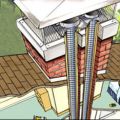CHIMNEY RELINING

There was a time when chimneys were not lined.Much property was lost due to the lack of that protection.
In 1904, the National Fire Prevention Association (NFPA) prepared its first codification on chimneys and fireplaces. That codification has undergone many changes. The most recent standard is NFPA 211, 2013.Here we will concentrate on Chapter 4 (General Requirements) and Chapter 7 (Masonry Chimneys).
Naturally, any change in the lining of the chimney must be done according to current NFPA standards in order for that property to be insurable.
First, from Chapter 4 (General Requirements) we get this: “Castable” or plastic refractories used to line chimneys or connectors shall be the equivalent in resistance to heat and erosion by flue gases to that of… fireclay brick.” Fireclay brick has a heat transfer thermal conductivity of 500 degrees Centigrade, 932 degrees Fahrenheit. It becomes more important, however, when the lining supports are considered. According to NFPA 211, Chapter 4, “Lining made of castable or plastic [ceramic] refractories shall be secured to the supporting walls by anchors made of corrosion-resistant steel capable of supporting the refractoryload at 1,500 degrees Fahrenheit, 816 degrees Centigrade.” Some definitions might help:
• Thermal conductivity is "the quantity of heat transmitted through a unit thickness of a material - in a direction normal to a surface of unit area - due to a unit temperature gradient under steady state conditions," according to www.engineeringtoolbox.com.
• Castable liners: to begin with, a castable liner exists to protect the chimney’s masonry from corrosion from the products of combustion. It’s mixed like cement and fills the void spaces around the flues. This liner would be perhaps the best choice among all the options for your chimney.However, it may not be the easiest choice for relining one.
• Refractory—its definition is “resistance to heat.”
It follows that since yours is not a new construction, you’ll be faced with a retrofit of your existing chimney. Unless that chimney has fallen, you must now reline it to fit the standards as closely as possible. Therefore, we will assume a standing structure placed on a code-matching foundation.It’s small consolation to know that if the house burns down, the chimney will continue to stand. The mason who works on your chimney relining must know:
• The concrete or noncombustible material on which the chimney has been placed has a fire resistance rating of not less than 3 hours.
• That if it was built according to existing code, it does not require the building itself in order to stand and the load is transferred to the ground, and
• There may be limitations on corbeling of masonry chimneys, processes of widening the chimney’s base. There are many requirements for corbels; only somebody familiar with the NFPA Standard 211 should be selected to do the work.
The standard is extensive. There are requirements for flue sizes, proximity to roof structures, pass-throughs for ceilings and floors. There are numerous standards for cleanout facilities, including standards for doors—distances from floors and markings for the door.
The person who works on this chimney relining must know where the bottom of the flue must be positioned. He must know how to “firestop” all spaces through which the chimney passes with noncombustible material. He must know to use galvanized steel or noncombustible sheet material where the chimney passes close to wood joists, beams, or headers.
There are other concerns. Included here are reinforcement for seismic and wind activity, thimbles (pass-through fittings for chimneys) and smoke tests where the chimney is proved to be tight.
Source: Click Here



